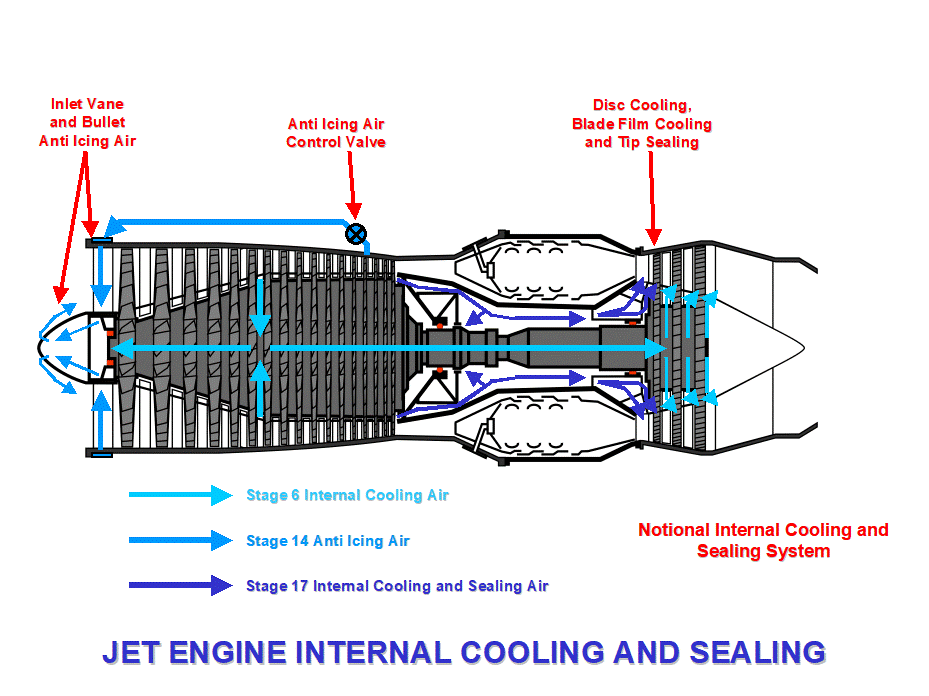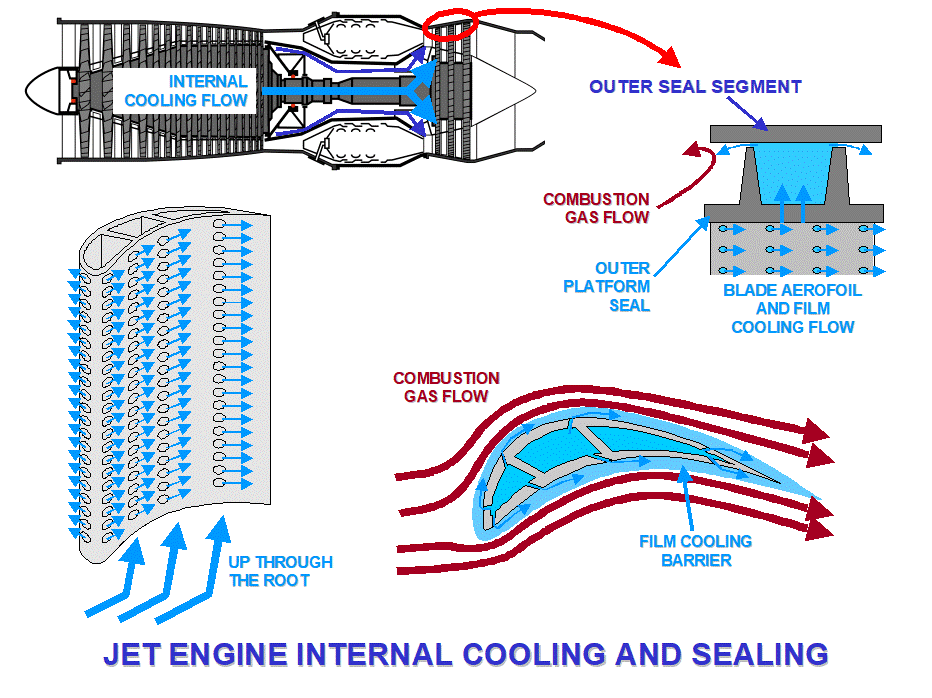CHAPTER 7 – INTERNAL COOLING AND SEALING
INTERNAL COOLING AND SEALING SYSTEM – System Overview
System Overview
Jet engines, like piston engines are ‘Heat’ engines, that is, they generate their power by using heat to rapidly expand the air, which passes through it. The temperatures generated are extremely high, in some cases higher than the metal components can actually withstand.
The reason the engines don’t just melt and fall apart, is because of the internal Cooling and Sealing flows.
Cooling
The cooling flows are provided, as the name suggests, to protect the metal components from these damaging temperatures.
One cooling flow is described in Chapter 2 Cycles, which is the dilution air into the combustion chambers. Without this flow the combustion chambers would simply melt and disintegrate.
Similarly, the turbine blade and nozzle guide vane aerofoils need to be cooled or they too would simply disappear. Additionally, the cooling airflows ensure the hot gasses do not impinge on the turbine disc rims, preventing potential disc failure
Sealing
Sealing is required to ensure the engine runs as efficiently as possible, i.e. ensuring that all the high energy hot gas flow passes between the turbine aerofoil sections and not over the tip or through the root area.
In addition, the bearing chambers are sealed with this airflow; see Chapter 4 Jet Engine Oil System for details.
System Description
Air is taken from the compressor via internal passageways to various sections of the engine.
The stage of compressor used as a source is always a higher pressure than the gas flow passing through the section of the engine requiring cooling and sealing. For instance the high pressure front stages of the turbine, would need air from the rear of the compressor (see Chapter 2 Cycle), as this is the highest pressure within the engine. Therefore the higher pressure compressor air can be fed to the front turbine section and then it will flow into the gas stream, details of typical airflows can be seen on the following pages.
With a few exceptions, cooling and sealing air flows are uncontrolled, that is when the engine is running, the air flows through the internal passageways.
In addition to cooling air flows, there is also a requirement for heating airflows. The front of the engine can be subject to ice build up in certain conditions, therefore a heating flow to get rid of the ice is required to keep the engine running efficiently.
Icing conditions are not constant, so the anti-icing airflows are pilot selectable as the need arises.

INTERNAL COOLING AND SEALING SYSTEM – Blades and NGV’s
History – No Cooling
In early designs, turbine blades (blades and NGV’s) were solid and had no cooling airflows. By design and progress, Turbine Entry Temperatures (TET) rose to values that the turbine blades could not withstand, they would simply melt and be blasted out the rear of the engine with the gas flow.
Therefore a method of being able to protect the blade material from these high TET’s was needed. In initial designs, aerofoils were simply made hollow and cooling air passed through from the root to the tip. It wasn’t long before progress raised TET’s even higher and ever more sophisticated designs were required.
Aerofoil Internal Cooling
High pressure compressor air is fed, via internal passageways through the engine to the aerofoil (blade and NGV’s). the air is then fed into the inside of the aerofoil.
Modern aerofoil internal air passageways are complex, with single, double or triple pass flows; that is, the air can pass through the aerofoil up to three times before escaping into the hot gas flow. Some designs had more than one source of cooling air.
Aerofoil ‘Film’ Cooling
Film cooling is a name given to a ‘blanket’ of cooling air around the outside of the aerofoil material.
The film cooling air fed to the aerofoil surface via hundreds of small holes allowing the air to escape into the hot gas flow. There are so many holes that the air creates a film or barrier between the aerofoils and the hot gasses preventing the hot exhaust gasses from coming into contact with the aerofoil material.
Tip Sealing
A small proportion of the same cooling air supply is fed to the blade tips, between two or three ‘lands’ or projections. When all the turbine blades are assembled into the turbine disc, these projections form a continuous channel around the blade tips.
The channel is pressurized by this air supply and prevents any hot gasses from travelling over the blade tip. The more energy passing between the blades means more energy can be extracted, i.e. making the engine more efficient.
General Points
The rotating turbine blades are generally fed with cooling and sealing air via the root, the none-rotating NGV’s can be fed from either the root or through the engine outer casings.
It is important that the cooling and sealing air is clean, any dirt (such as sand from desert area operations) can clog the film cooling holes resulting in blade failure; blade cooling design has to take this into consideration to ensure engine life. Internal air offtakes are usually in towards the centre of the engine, where any dirt would be centrifuged out to the tip area of compressor blades, reducing the contaminates in the cooling and sealing air.

Source: https://www.2473atc.org.uk/trainingMaterial/Master/MASTER%20jet%20engine%20propulsion/CHAPTER%207%20NOTES.doc
Web site to visit: https://www.2473atc.org.uk
Author of the text: indicated on the source document of the above text
If you are the author of the text above and you not agree to share your knowledge for teaching, research, scholarship (for fair use as indicated in the United States copyrigh low) please send us an e-mail and we will remove your text quickly. Fair use is a limitation and exception to the exclusive right granted by copyright law to the author of a creative work. In United States copyright law, fair use is a doctrine that permits limited use of copyrighted material without acquiring permission from the rights holders. Examples of fair use include commentary, search engines, criticism, news reporting, research, teaching, library archiving and scholarship. It provides for the legal, unlicensed citation or incorporation of copyrighted material in another author's work under a four-factor balancing test. (source: http://en.wikipedia.org/wiki/Fair_use)
The information of medicine and health contained in the site are of a general nature and purpose which is purely informative and for this reason may not replace in any case, the council of a doctor or a qualified entity legally to the profession.
The texts are the property of their respective authors and we thank them for giving us the opportunity to share for free to students, teachers and users of the Web their texts will used only for illustrative educational and scientific purposes only.
All the information in our site are given for nonprofit educational purposes